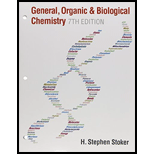
(a)
Interpretation:
Common name for the given
Concept Introduction:
Common names for aldehyde are a single word and not like alcohol or ether which contains two words. The counting of carbon atoms leads to the naming of aldehyde. From the total number of carbon atoms present in the given aldehyde, the common name of the aldehyde can be derived. For the counting of 1 to 4 carbon atoms, the name involves form-, acet-, propion-, and butyr- as prefix.
For compounds that contain benzene ring, the common name is obtained as derivatives of benzaldehyde.
(b)
Interpretation:
Common name for the given aldehyde has to be given.
Concept Introduction:
Common names for aldehyde are a single word and not like alcohol or ether which contains two words. The counting of carbon atoms leads to the naming of aldehyde. From the total number of carbon atoms present in the given aldehyde, the common name of the aldehyde can be derived. For the counting of 1 to 4 carbon atoms, the name involves form-, acet-, propion-, and butyr- as prefix.
For compounds that contain benzene ring, the common name is obtained as derivatives of benzaldehyde.
(c)
Interpretation:
Common name for the given aldehyde has to be given.
Concept Introduction:
Common names for aldehyde are a single word and not like alcohol or ether which contains two words. The counting of carbon atoms leads to the naming of aldehyde. From the total number of carbon atoms present in the given aldehyde, the common name of the aldehyde can be derived. For the counting of 1 to 4 carbon atoms, the name involves form-, acet-, propion-, and butyr- as prefix.
For compounds that contain benzene ring, the common name is obtained as derivatives of benzaldehyde.
(d)
Interpretation:
Common name for the given aldehyde has to be given.
Concept Introduction:
Common names for aldehyde are a single word and not like alcohol or ether which contains two words. The counting of carbon atoms leads to the naming of aldehyde. From the total number of carbon atoms present in the given aldehyde, the common name of the aldehyde can be derived. For the counting of 1 to 4 carbon atoms, the name involves form-, acet-, propion-, and butyr- as prefix.
For compounds that contain benzene ring, the common name is obtained as derivatives of benzaldehyde.
Trending nowThis is a popular solution!

Chapter 15 Solutions
Bundle: General, Organic, and Biological Chemistry, 7th + OWLv2 Quick Prep for General Chemistry, 4 terms (24 months) Printed Access Card
- Describe any two heteropolysaccharides in terms of: a. The types of monosaccharides involved b. types of glycosidic linkages, and c. possible hydrolysatesarrow_forwardIdentify the component monosaccharides of each of the following compounds and describe the type of glycosidic linkage in each.arrow_forwardIdentify the class of macromolecules and the functional groups present in the molecule below. Discuss briefly, the physical properties (at least 2) and kinds of reactions (at least 2) it may undergo based on the functional group that is present. `NH "NH2 OH онarrow_forward
- Draw the enantiomer structure of the following given carbohydrates. Be sure to include appropriate D or L specification.arrow_forwardWhich of the following organic compound doesnot dissolve in water? glycerol propane propanoic acid propanol H H-C Н Н H-с-с-с Н- OH HICIH H-C c-c 1 Н OH H -+ Н HICIH H Н H H C C H H OH 5-о-т OH -C-H -H OHarrow_forwardAlthough the first two carbons of fructose and glucose are identical in structure to DHAP and GADP (from glycolysis), DHAP and GADP equilibriate on their in solution to favor the ketone over the aldehyde, while fructose and glucose do not. Why? a)The larger size of the molecule sterically hinders the isomerization b)The larger sugars have more OH groups which hydrogen bond and disrupt isomerization c)The larger sugars cyclize, and there is no carbonyl to isomerize in the cyclic form d)The larger sugars cyclize, and in the cyclic form the hydrogen bonding is very strong e)The larger sugars are less soluble in water than the smaller sugarsarrow_forward
- With the given structures, arrange the following compounds in order of decreasing reactivity towards hydrolysisarrow_forwardExamine the structures of the following molecules. In each compound circle and identify by name each functional group. a) ethanolamine b) Glucosamine c) Threonine H₂N-C-C-OH H₂ H₂ H₂N HO OH d) Phosphoenolpyruvate с H₂N-CH OH OH OH HC - OH 1 CH3 OH T O=P-O O H₂C=C-C OHarrow_forwardUsing the picture provided, match the correct name of each of the functional groups highlighted in blue.arrow_forward
- Draw the respective enantiomer of the following sugar molecules: D-glyceraldehyde D-glucose D-mannose D-fructosearrow_forwardWhat carbon, by number designates the aldehyde group? * CH,OH C=0 HO- -H- Но- -H- H- -ОН ČH,OH Carbon 1 O Carbon 2 O Carbon 3 Carbon 4 Carbon 5 Carbon 6 None of the abovearrow_forwardChoose the correct structure for thiamine hydrochloride at pH 10. H3C H3C N NH₂ NH₂ CI- A CI- с CH3 CH3 HCI -OH OO H3C H3C N NH3 NH₂ CI- B D CH3 S CH3 S HCI OH -OHarrow_forward
 Human Anatomy & Physiology (11th Edition)BiologyISBN:9780134580999Author:Elaine N. Marieb, Katja N. HoehnPublisher:PEARSON
Human Anatomy & Physiology (11th Edition)BiologyISBN:9780134580999Author:Elaine N. Marieb, Katja N. HoehnPublisher:PEARSON Biology 2eBiologyISBN:9781947172517Author:Matthew Douglas, Jung Choi, Mary Ann ClarkPublisher:OpenStax
Biology 2eBiologyISBN:9781947172517Author:Matthew Douglas, Jung Choi, Mary Ann ClarkPublisher:OpenStax Anatomy & PhysiologyBiologyISBN:9781259398629Author:McKinley, Michael P., O'loughlin, Valerie Dean, Bidle, Theresa StouterPublisher:Mcgraw Hill Education,
Anatomy & PhysiologyBiologyISBN:9781259398629Author:McKinley, Michael P., O'loughlin, Valerie Dean, Bidle, Theresa StouterPublisher:Mcgraw Hill Education, Molecular Biology of the Cell (Sixth Edition)BiologyISBN:9780815344322Author:Bruce Alberts, Alexander D. Johnson, Julian Lewis, David Morgan, Martin Raff, Keith Roberts, Peter WalterPublisher:W. W. Norton & Company
Molecular Biology of the Cell (Sixth Edition)BiologyISBN:9780815344322Author:Bruce Alberts, Alexander D. Johnson, Julian Lewis, David Morgan, Martin Raff, Keith Roberts, Peter WalterPublisher:W. W. Norton & Company Laboratory Manual For Human Anatomy & PhysiologyBiologyISBN:9781260159363Author:Martin, Terry R., Prentice-craver, CynthiaPublisher:McGraw-Hill Publishing Co.
Laboratory Manual For Human Anatomy & PhysiologyBiologyISBN:9781260159363Author:Martin, Terry R., Prentice-craver, CynthiaPublisher:McGraw-Hill Publishing Co. Inquiry Into Life (16th Edition)BiologyISBN:9781260231700Author:Sylvia S. Mader, Michael WindelspechtPublisher:McGraw Hill Education
Inquiry Into Life (16th Edition)BiologyISBN:9781260231700Author:Sylvia S. Mader, Michael WindelspechtPublisher:McGraw Hill Education





